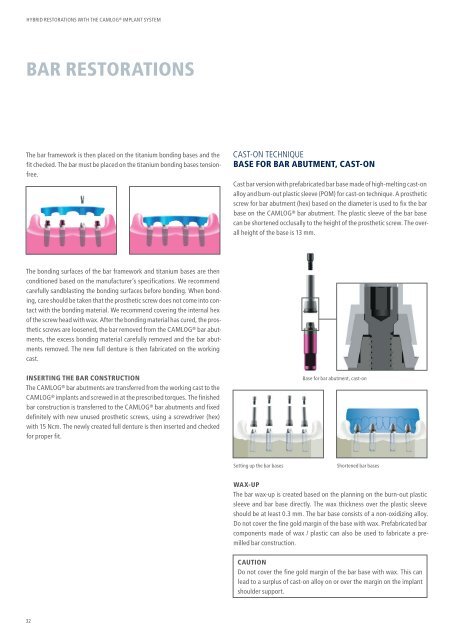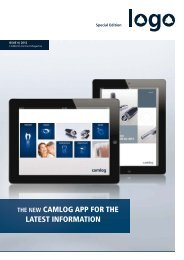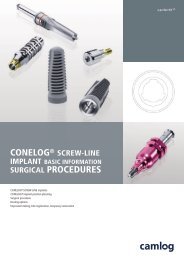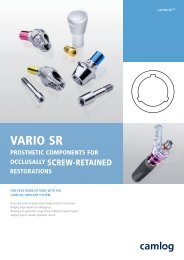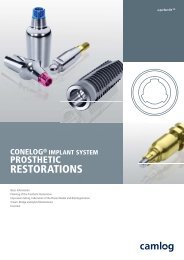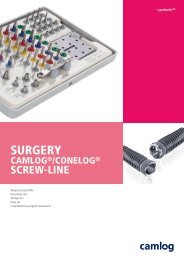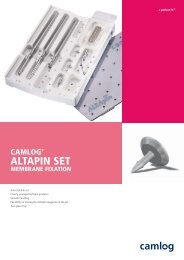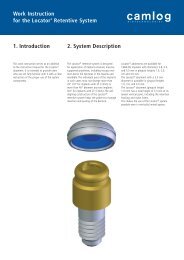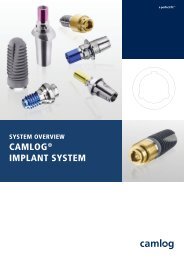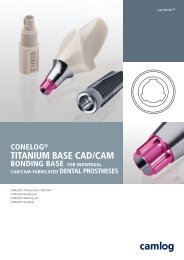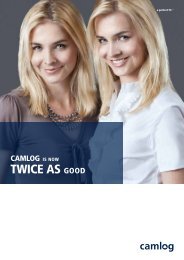Hybrid Restorations with the CAMLOG Implant System (PDF
Hybrid Restorations with the CAMLOG Implant System (PDF
Hybrid Restorations with the CAMLOG Implant System (PDF
Create successful ePaper yourself
Turn your PDF publications into a flip-book with our unique Google optimized e-Paper software.
HYBRID RESTORATIONS WITH THE <strong>CAMLOG</strong> ® IMPLANT SYSTEM<br />
BAR RESTORATIONS<br />
The bar framework is <strong>the</strong>n placed on <strong>the</strong> titanium bonding bases and <strong>the</strong><br />
fit checked. The bar must be placed on <strong>the</strong> titanium bonding bases tensionfree.<br />
The bonding surfaces of <strong>the</strong> bar framework and titanium bases are <strong>the</strong>n<br />
conditioned based on <strong>the</strong> manufacturer’s specifications. We recommend<br />
carefully sandblasting <strong>the</strong> bonding surfaces before bonding. When bonding,<br />
care should be taken that <strong>the</strong> pros<strong>the</strong>tic screw does not come into contact<br />
<strong>with</strong> <strong>the</strong> bonding material. We recommend covering <strong>the</strong> internal hex<br />
of <strong>the</strong> screw head <strong>with</strong> wax. After <strong>the</strong> bonding material has cured, <strong>the</strong> pros<strong>the</strong>tic<br />
screws are loosened, <strong>the</strong> bar removed from <strong>the</strong> <strong>CAMLOG</strong> ® bar abutments,<br />
<strong>the</strong> excess bonding material carefully removed and <strong>the</strong> bar abutments<br />
removed. The new full denture is <strong>the</strong>n fabricated on <strong>the</strong> working<br />
cast.<br />
INSERTING THE BAR CONSTRUCTION<br />
The <strong>CAMLOG</strong> ® bar abutments are transferred from <strong>the</strong> working cast to <strong>the</strong><br />
<strong>CAMLOG</strong> ® implants and screwed in at <strong>the</strong> prescribed torques. The finished<br />
bar construction is transferred to <strong>the</strong> <strong>CAMLOG</strong> ® bar abutments and fixed<br />
definitely <strong>with</strong> new unused pros<strong>the</strong>tic screws, using a screwdriver (hex)<br />
<strong>with</strong> 15 Ncm. The newly created full denture is <strong>the</strong>n inserted and checked<br />
for proper fit.<br />
32<br />
CAST-ON TECHNIQUE<br />
BASE FOR BAR ABUTMENT, CAST-ON<br />
Cast bar version <strong>with</strong> prefabricated bar base made of high-melting cast-on<br />
alloy and burn-out plastic sleeve (POM) for cast-on technique. A pros<strong>the</strong>tic<br />
screw for bar abutment (hex) based on <strong>the</strong> diameter is used to fix <strong>the</strong> bar<br />
base on <strong>the</strong> <strong>CAMLOG</strong> ® bar abutment. The plastic sleeve of <strong>the</strong> bar base<br />
can be shortened occlusally to <strong>the</strong> height of <strong>the</strong> pros<strong>the</strong>tic screw. The overall<br />
height of <strong>the</strong> base is 13 mm.<br />
Base for bar abutment, cast-on<br />
Setting up <strong>the</strong> bar bases Shortened bar bases<br />
WAX-UP<br />
The bar wax-up is created based on <strong>the</strong> planning on <strong>the</strong> burn-out plastic<br />
sleeve and bar base directly. The wax thickness over <strong>the</strong> plastic sleeve<br />
should be at least 0.3 mm. The bar base consists of a non-oxidizing alloy.<br />
Do not cover <strong>the</strong> fine gold margin of <strong>the</strong> base <strong>with</strong> wax. Prefabricated bar<br />
components made of wax / plastic can also be used to fabricate a premilled<br />
bar construction.<br />
CAUTION<br />
Do not cover <strong>the</strong> fine gold margin of <strong>the</strong> bar base <strong>with</strong> wax. This can<br />
lead to a surplus of cast-on alloy on or over <strong>the</strong> margin on <strong>the</strong> implant<br />
shoulder support.


